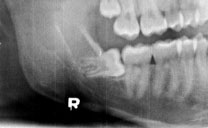Wisdom teeth: Making the removal as painless as possible

Photo courtesy of Melissa Irish
An impacted wisdom tooth is positioned perpendicular to the adjacent teeth and will need to be removed.
April 2, 2018
Surgeries to remove impacted wisdom teeth are common, as are the videos of mumbling teenagers following their procedure. However, there is a lot more that goes into these operations than just who will be Snapchatting the aftermath.
Weeks before the surgery
The first step is to understand the reason for the operation. Wisdom teeth are molars that emerge when one is between 17 and 25 years old. If they are impacted, they either don’t have enough room to erupt or will do so abnormally. To prevent pain and other side effects, these teeth are instead surgically removed.
Before the surgery, it is important to visit the dentist or oral surgeon who will perform the procedure. There you can discuss preferred anesthesia options, medications, and time needed to heal as well as ask any questions you have.
It is essential to keep the area around the wisdom teeth clean before the operation. This can be done by flossing thoroughly and using mouthwash daily. By taking this precaution, you prevent infections that could complicate the surgery.
24 hours before the surgery
Since it will be difficult to chew after the procedure, take time to purchase soft, non-sticky foods to eat afterwards. Ice cream, Jello, chicken broth, and applesauce are all acceptable choices, as they don’t take much effort to eat.
To make sure that everything goes as planned, follow the directions given by your dentist or surgeon. If that means that you cannot eat for several hours, push through it. It’s better than to be hungry than to risk a serious complication. Also remember to take any prescribed medications at the instructed time.
On your way to the operation, wear comfortable clothes that you don’t mind getting dirty. If you are going to need an IV, make sure to wear short sleeves so that the surgeon can better access your arm.
After the surgery
Immediately after the procedure, have someone else drive you home in order to make sure that you get there safely. There, get yourself cozy, use ice packs to control swelling, and switch out the gauze over the damaged gums every hour.
Dry sockets occur when the blood clot shifts, painfully exposing the bone. To prevent these, avoid exercise for a few days afterwards and do not drink from straws. If they do occur, go straight to a dentist to have them treated.
You will likely be given painkillers after the operation, so be sure to make a schedule and set alarms to ensure that you take the correct mediations at the proper times. After a day or two, you can begin to phase out the medication unless told otherwise by your surgeon or dentist.
Many people are given dissolving stitches, but for those who did not, remember to schedule an appointment to have them removed.
With this advice in mind, your surgery should go by without complications. Wisdom teeth removals may be common, but the mistakes don’t have to be.






